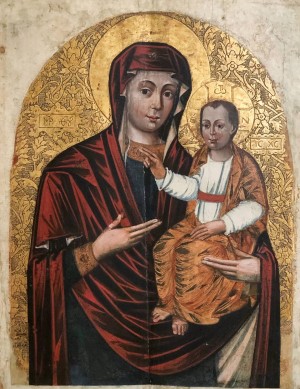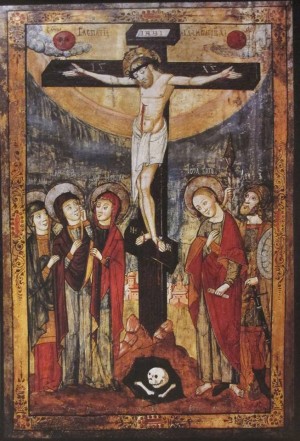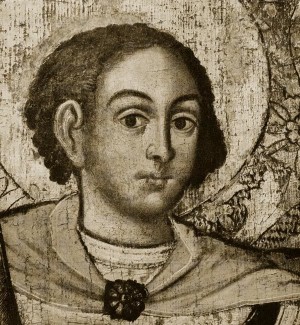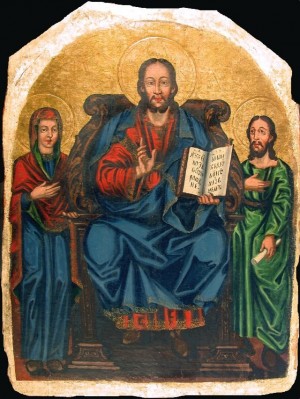
- Biography
- Portfolio of works
- Bibliography
Biography
Dates of life and death are unknown. We only know that he was born in Sudova Vyshnia, Lviv region, in the 17th century. Life and democracy of this town affected the creativity of the artist. Along with other craft workshops in Sudova Vyshnia, it was opened a paint shop. Icon painters of Sudova Vyshnia focused more on the art of the Christian East. However, the painters copied neither the Byzantine icons nor the Ukrainian, which were created during the past centuries. They always painted with their own special national features in a new era. The painters of a new cell, preserving the traditions of Lviv painting, that is, the orientation towards the Western European painting, nevertheless chose another way of the creativity – a more iconic depicting in the traditions of the Eastern Church. Such painting was generally close to the Christians of the Russian Church in Halychyna and Transcarpathia (in particular, Eastern Church), taking into account the reserved attitude of the Russian population to everything Latin. The creativity of the artists of Sudova Vyshnia is characterized by the expressive personal styles. Their works revealed that there was no authority over them because the means they chose were quite different from each other. Their style of painting was different.
As historians note, one of the leading artists of Sudova Vyshnia was Ilia Brodlakovych, who started his career far back in the 40s of the 17th century. After a while, he moved to Mukachevo. The works of the famous Sudova Vyshnia’s artist were in great demand in this Transcarpathian town, where he settled and lived constantly. This course of events testifies to the close cultural and historical co-operation between Halychyna and Transcarpathia.
The most famous works of Brodlakovych – the icons "Intercession" (1646), "Archangel Michael" (1666), and the icon "Saviour on the throne" (1666) from Ruske village near Mukachevo, characterized by expressive life colour. In general, as noted by art historians, his painting is characterized by linearity of form and locality of colour. Compositional scheme and decorativeness of the previous era were relevant in his creativity. Illia Broadlakovych thought as a Baroque master, able to provide a Byzantine geometric "wooden" form with unexpected dynamism, scale and monumentality. Concerning the depiction of the accelerated rapid movement, as it can be seen in the icon of Archangel Michael, Brodlakovych outstripped numerous of his contemporaries who sometimes used the more overall form but restrained themselves in the movement and means of images psychologizing. Later works signed by Illia Brodlakovych (the 60s of the 17th century) such as "St. Nicholas", "Christ the Almighty", "Archangel Michael's Cathedral", are much calmer, although painted with a fine decorative feeling.
In the church of Vilkhovytsia village, Mukachevo district, there is an icon of the Adoration of the Shepherds (1672) and another one, signed by the artist. The artist put his signature as follows: "Illia Brodlakovych Painter of Sudova Vyshnia, Painter of Mukachevo" or " Painter of Sudova Vyshnia". Art critics suggest that the discrepancy between the style of the works with the signature of Brodlakovych attest to two masters with such a name, perhaps a father and a son.
The creativity of Illia Brodlakovych, like all painters of Sudova Vyshnia, is a notable phenomenon of the Ukrainian art of the 17th – the mid-18th century. They played an important role in establishing a new painting system of the sacral painting of the 17th century. They reinterpreted the Byzantine and West European heritage, and on the basis of the powerful Ukrainian culture and tradition of sacred art, it was created iconography that met the religious and philosophical requirements of the new era.
The works of Illia Brodlakovych are stored at the museums of Ukraine, in particular, in Lviv.
Portfolio of works
© Brodlakovych Illia
© Brodlakovych Illia
Matching content source: photos of the art works are taken from public sources
Sorry, we did not find anything
Sorry, we did not find anything
Bibliography
Публікації в Інтернет-ЗМІ
Бродлакович Ілля // Вікіпедія. – https://uk.wikipedia.org/wiki/Бродлакович_Ілля
Бродлакович Ілля // Turkaramamotoru.com. – https://www.turkaramamotoru.com/uk/Бродлакович-Ілля-140436.html
- Biography
- Portfolio of works
- Bibliography








